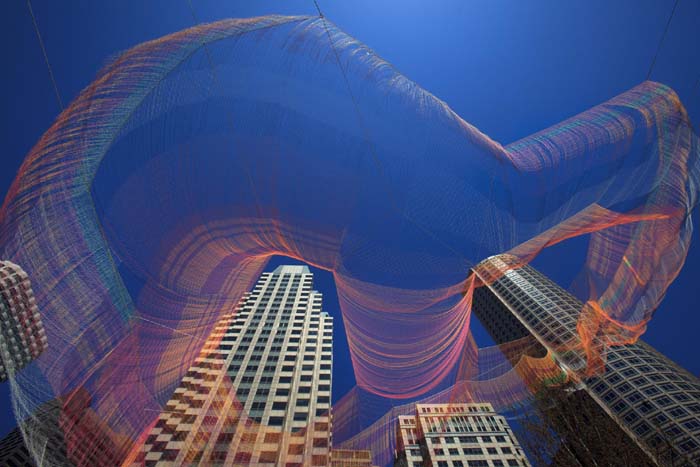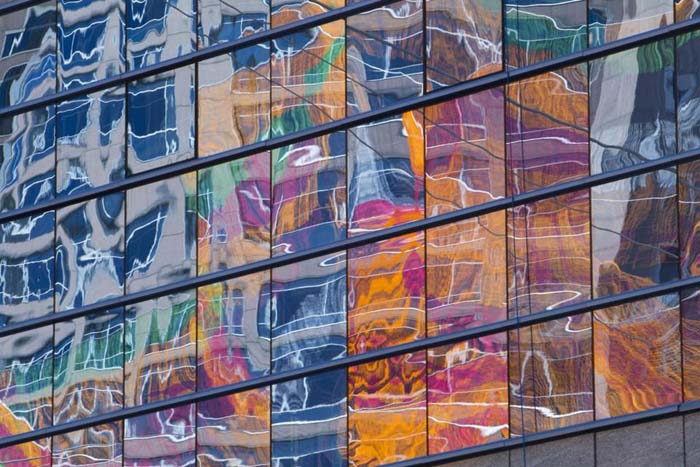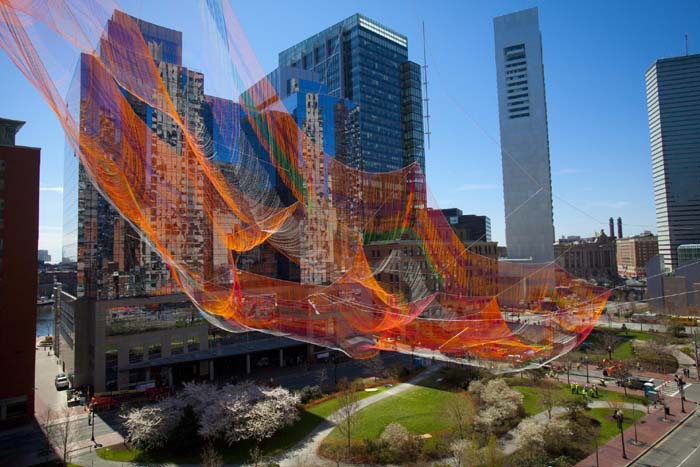Floating sculpture rises over the Greenway
Half-acre net tethered between buildings to waft overhead until Oct.
Is it a giant jellyfish? A spaceship? An outsized butterfly net?
Whatever it is, Brookline artist Janet Echelman’s light-as-air sculpture, which turned heads as it soared over the Rose Fitzgerald Kennedy Greenway on Sunday morning, took a village to raise.
Arriving in the wee hours of the morning, crews closed roads to make way for the project’s six cranes. With roughly 50 workers on site, the sculpture — a vast net of rusty orange, magenta, and green hues that will float above the Greenway until October — emerged from an impossibly small wooden crate, hoisted, inch by inch and crane by crane, to span roughly half an acre in the air.
It was a colossal choreography of man and machine, as cranes lifted one portion of the net, then another, only to hand them off to workers who hand-winched them to buildings around the Greenway, fastening them tight.
But if hoisting the sculpture resembled what organizers called a “crane ballet,” its planning and design were equally intricate — a creative collaboration between Echelman, structural engineers, software developers, lighting specialists, building contractors, political officials, the Rose Fitzgerald Kennedy Greenway Conservancy, owners of nearby property, and more.
“It’s a bit of a coming-out party for public art on the Greenway,” said Conservancy executive director Jesse Brackenbury.
It is also a work of collective imagination. “I ask what is possible, and then the engineers tell me this is possible, and within that I start to design,” said Echelman, 49, who has constructed similar aerial sculptures around the world.
In Boston, Echelman is exploring a contrast between the ephemeral and the permanent: “I started thinking about the way Boston ambitiously reshaped its environment,” she explained. The sculpture’s three voids are meant to evoke three hills that once dominated Boston’s landscape but were razed to create landfill. Similarly, its colored bands are intended to recall the elevated highway that defined the Greenway space before the Big Dig banished it below ground.
The Greenway commission, the Brookline artist’s first in Boston, is her most complex project to date, incorporating a structural net to support the floating form.
“It’s basically a spider web — a stiff spider web that’s cast between supporting buildings, and it’s the spider web that is holding her sculptural net,” said Patrick McCafferty, a structural engineer at Arup, the engineering firm Echelman works with to design her creations.

The sculpture emerged from an impossibly small wooden crate, hoisted, inch by inch and crane by crane, to span roughly half an acre in the air. Dina Rudick/Globe Staff
Constructed of high-tech rope that is eight times stronger than steel, the web takes a shape that is largely determined by the surrounding built environment, including which buildings have excess load-bearing strength.
“We’re tapping into the unbridled potential energy of the site,” said McCafferty, noting that the kinematic sculpture demanded structural and engineering analyses more complex than most buildings. “You usually see buildings as static, staid things, but they’re extremely dynamic, and that’s manifested through the sculpture’s form.”
Arriving mid-morning sporting a hard hat, Echelman marveled at her first sighting of the Greenway sculpture, weighing roughly 1 ton and ascending 365 feet at its highest point. Floating between anchor points at One International Place, 125 High Street, and the InterContinental Hotel, the sculpture boasts more than a half-million knots and more than 100 miles of rope.
The work, which Echelman has yet to title (“I wanted to meet it first”), may appear gossamer light, exquisitely sensitive to the subtlest environmental shift as it shimmers and pulses in the breeze. By another measure, however, it is a giant sail: a 2,000-pound kinetic mass that will exert wildly variable forces on the buildings that support it.
“We happen to be standing in one of the most windy corridors of downtown Boston,” said McCafferty, adding that the sculpture is designed to withstand wind speeds of 105 miles per hour. “We’re talking about anywhere between 50 and 70,000 pounds of force the net is putting on any one of these buildings under a wind event, so it’s not for kids.”
Neither is its installation.

The sculpture emerged from an impossibly small wooden crate, hoisted, inch by inch and crane by crane, to span roughly half an acre in the air. Dina Rudick/Globe Staff
“It can feel as complicated or more so as building a high-rise,” said Micah O’Neil, a senior project manager at Shawmut Design and Construction, which coordinated the installation.
The sculpture is a study in contrasts, not only between its own strength and flexibility, but also between the rigidity of the built environment and what Echelman deems its “monumental softness.” And while it employs state-of-the-art engineering, a team of craftsmen in Washington state also used age-old nautical techniques to hand-splice and knot the nets.
“This is very much about handcraft and ancient traditions as well as about the newest technology,” said Echelman, adding that she uses bespoke Autodesk software to design her sculptures.
The work, whose cost the Conservancy estimates at $1.25 million, is part of the nonprofit’s push to use art to lure visitors to the park, temporarily transforming it with contemporary exhibits.
“It changes perceptions of what the public thinks of their space,” said Lucas Cowan, the Greenway’s curator for public art. “We knew this was going to challenge a lot of people in regards to what they were viewing and what the notion of public art was. It’s not just a bronze or a static object.”
Cowan is now designing programming to complement the sculpture, which joins Shinique Smith’s mural in Dewey Square Park and a planned sculptural installation this June at the Chinatown gate.
Over the next week, Echelman will fine-tune the sculpture’s lighting, which will shift with the wind at night.
Ultimately, she said, the work is about the viewer’s experience. “If you come and lie down in the grass underneath and look up and notice the changing patterns of wind, I feel that you have experienced the work,” she said, “creating your own meaning, finding your own observations about nature and the city.”
The sculpture emerged from an impossibly small wooden crate, hoisted, inch by inch and crane by crane, to span roughly half an acre in the air.
Malcolm Gay can be reached at malcolm.gay@globe.com. Follow him on Twitter at @malcolmgay
———————————————————-
Originally published by Malcolm Gay for The Boston Globe
























